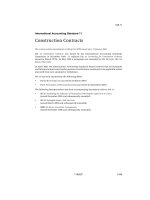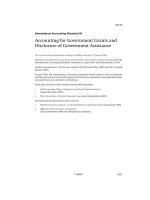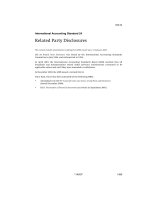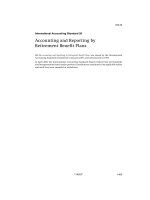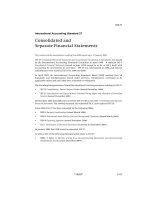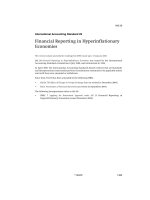chuẩn mực kế toán quốc tế ias 16
Bạn đang xem bản rút gọn của tài liệu. Xem và tải ngay bản đầy đủ của tài liệu tại đây (96.04 KB, 5 trang )
IAS 16:
I. MULTIPLE-CHOICE QUESTIONS
1. Healthy Inc. bought a private jet for the use of its top-ranking officials. The cost of the private jet is
$15 million and can be depreciated either using a com-posite useful life or useful lives of its major
components. It is expected to be used over a period of 7 years. The engine of the jet has a useful life of
5 years. The private jet’s tires are replaced every 2 years. The private jet will be depreciated using the
straight-line method over
(a) 7 years composite useful life.
(b) 5 years useful life of the engine, 2 years use-ful life of the tires, and 7 years useful life
applied to the balance cost of the jet.
(c) 2 years useful life based on conservatism (the lowest useful life of all the parts of the jet).
(d) 5 years useful life based on a simple average of the useful lives of all major components
of the jet.
2. An entity imported machinery to install in its new factory premises before year-end. However, due
to circumstances beyond its control, the machinery was delayed by a few months but reached the
factory premises before year-end. While this was happening, the entity learned from the bank that it
was being charged interest on the loan it had taken to fund the cost of the plant. What is the proper
treatment of freight and interest expense under IAS 16?
(a) Both expenses should be capitalized.
(b) Interest may be capitalized but freight should be expensed.
(c) Freight charges should be capitalized but in-terest cannot be capitalized under these
circumstances.
(d) Both expenses should be expensed.
3. XYZ Inc. owns a fleet of over 100 cars and 20 ships. It operates in a capital-intensive industry and
thus has significant other property, plant, and equip-ment that it carries in its books. It decided to
revalue its property, plant, and equipment. The company’s
accountant has suggested the alternatives that follow. Which one of the options should XYZ Inc.
select in order to be in line with the provisions of IAS 16?
(a) Revalue only one-half of each class of prop-erty, plant, and equipment, as that method is
less cumbersome and easy compared to re-valuing all assets together.
(b) Revalue an entire class of property, plant, and equipment.
(c) Revalue one ship at a time, as it is easier than revaluing all ships together.
(d) Since assets are being revalued regularly, there is no need to depreciate.
4. An entity installed a new production facility and incurred a number of expenses at the point of
instal-lation. The entity’s accountant is arguing that most expenses do not qualify for capitalization.
Included in those expenses are initial operating losses. These should be
(a) Deferred and amortized over a reasonable period of time.
(b) Expensed and charged to the income statement.
(c) Capitalized as part of the cost of the plant as a directly attributable cost.
(d) Taken to retained earnings since it is unrea-sonable to present it as part of the current year’s
income statement.
1
5. IAS 16 requires that revaluation surplus resulting from initial revaluation of property, plant, and
equip-ment should be treated in one of the following ways. Which of the four options mirrors the
requirements of IAS 16?
(a) Credited to retained earnings as this is an unrealized gain.
(b) Released to the income statement an amount equal to the difference between the depre-ciation
calculated on historical cost vis-à-vis revalued amount.
(c) Deducted from current assets and added to the property, plant, and equipment.
(d) Debited to the class of property, plant, and equipment that is being revalued and cred-ited to a
reserve captioned “revaluation surplus,” which is presented under “equity.”
Example – measurement at initial recognition
Example 1
Paul Boyle incurs the following costs in relation to the construction of a new factory and the
introduction of its products to the local market.
€’000
Site preparation costs :240
Materials used :1,500
Labour costs, including €90,000 incurred during an industrial dispute.
No construction occurred during the period of the dispute. :3,190
Testing of various processes in factory :150
Consultancy fees re installation of equipment :220
Relocation of staff to new factory :110
General overheads :500
Costs to dismantle the factory at end of its useful life in 10 years time :100
Question: How much of the costs should be capitalised?
Example 2
(a) A company buys an aircraft for €9,000,000. Under civil aviation rules, the aircraft
requires a major inspection every three years at a cost of €200,000. Three years after
the purchase of the aircraft it undergoes its first major inspection. The costs in relation to
the inspection amounted to €220,000.
(b) On 1 June 2009, a company spent €100,000 to replace the wall lining of one of its two
furnaces. The furnace had been acquired six years previously and had a carrying value,
at 1 June 2009, amounting to €420,000. Of this amount, €20,000 related to the original
wall lining.
Question: Explain how each of these matters should be accounted for in accordance with
the requirements of IAS 16.
Example 3
2
Facts
Extravagant Inc. is installing a new plant at its production facility. It has incurred these costs:
1. Cost of the plant (cost per supplier’s invoice plus taxes) $2,500,000
2. Initial delivery and handling costs $200,000
3. Cost of site preparation $600,000
4. Consultants used for advice on the acquisition of the plant $700,000
5. Interest charges paid to supplier of plant for deferred credit $200,000
6. Estimated dismantling costs to be incurred after 7 years $300,000
7. Operating losses before commercial production $400,000
Required
Please advise Extravagant Inc. on the costs that can be capitalized in accordance with IAS 16.
Example 4
On 1 January 20X1 an entity purchased an item of equipment for CU600,000, including CU50,000
refundable purchase taxes. The purchase price was funded by raising a loan of CU605,000 (including
CU5,000 loan raising fees). The loan is secured against the equipment.
In January 20X1 the entity incurred costs of CU20,000 in transporting the equipment to the entity’s
site and CU100,000 in installing the equipment at the site. At the end of the equipment’s 10-year
useful life the entity is required to dismantle the equipment and restore the land upon which the factory
is build. The present value of the cost of dismantling the equipment and restoring the environment is
estimated to be CU100,000.
In January 20X1 the entity’s engineer incurred the following costs in modifying the equipment so that
it can produce the products manufactured by the entity:
• Material – CU55,000
• Labour – CU65,000
• Depreciation of plant and equipment used to perform the modifications – CU15,000
In January 20X1 the entity’s production staff were trained in how to operate the new item of
equipment. Training costs included:
• Cost of an expert external instructor – CU7,000
• Labour – CU3,000
In February 20X1 the entity’s production team tested the equipment and the engineering team made
further modifications necessary to get the equipment to function as intended by management. The
following costs were incurred in the testing phase:
• Material, net of CU3,000 recovered from the sale of the scrapped output – CU21,000
• Labour – CU11,000
• Depreciation of plant and equipment used to perform the modifications – CU5,000
3
The equipment was ready for use on 1 March 20X1. However, because of low initial order levels the
entity incurred a loss of CU23,000 on operating the equipment during March. Thereafter the
equipment operated profitably.
What is the cost of the equipment at initial recognition?
Example 5– cost when payment is deferred
An entity acquired a plant for CU2,000,000 on two-years’ interest-free credit. An appropriate
discount rate is 10 per cent per year.
Example -Measurement of PPE after initial recognition
Example 6
(a) Asset X was bought for €500,000 five years ago and has been depreciated at 10% on
cost per annum. It is now revalued at €800,000. There is no change to the useful life.
(b) An item of land originally cost €30,000. Two years ago it was revalued to €35,000. The
value of the land has now fallen to €29,000. Assume the profit for the year before
adjusting for the fall in value of the land was €60,000.
Question: Show how the above items should be treated in the financial statements.
Example 7
Facts
Road Truckers Inc. has acquired a heavy road transporter at a cost of $100,000 (with no breakdown of
the component parts). The estimated useful life is 10 years. At the end of the sixth year, the power train
requires replacement, as further maintenance is uneconomical due to the off-road time required. The
re-mainder of the vehicle is perfectly roadworthy and is expected to last for the next four years. The
cost of a new power train is $45,000.
Required
Can the cost of the new power train be recognized as an asset, and, if so, what treatment should be
used?
Example 8
On 1 January 20X1 an entity acquired a plant for CU500,000. Management estimates the useful life
of the plant as five years measured from the date of acquisition. Furthermore, it estimates the residual
value of the plant as CU100,000. Management judges that the straight-line method reflects the
pattern in which it expects to consume the plant’s future economic benefits. At 31 December 20X1
the plant was damaged and its recoverable amount was estimated as CU300,000.
4
What is the carrying amount of the plant on 31 December 20X1?
Example – depreciation of major components
Ex 9
On 1 January 20X1 an entity acquired an item of heavy machinery for CU600,000. The machine is
made up of three components of equal value: (i) fixed parts—management estimates fixed parts have a
25-year useful life with no residual value; (ii) moving parts—management estimates moving parts have
a five-year useful life with no residual value; and (iii) a foundation—management estimates the
foundation has a 25-year useful life with no residual value. Furthermore, management judges that the
straight-line method reflects the pattern in which the entity expects to consume the future economic
benefits of all components of the machine.
Example – revised assessment of depreciation
Ex 10
On 1 January 20X1 an entity acquired an item of machinery for CU500,000. Management estimated
the useful life of the machine as 20 years and its residual value as nil. Furthermore, management
believed that the straight-line method reflects the pattern in which it expects to consume the machine’s
future economic benefits.
At the entity’s 31 December 20X5 financial year-end management’s assessments of the machine
changed. It now estimates the useful life of the machine as 25 years (measured from the date of
acquisition) and its residual value as CU100,000. Management continues to believe that the straight-
line method reflects the pattern in which it expects to consume the machine’s future economic benefits.
How must the entity account for the revised assessment of the machine in the year ended 31 December
20X5?
Examples – change in depreciation method
Ex 11
On 1 January 20X1 an entity acquired a machine for CU500,000. Management estimated the
machine’s residual value as nil. Furthermore, management believed that the diminishing balance
method computed at the rate of 8 per cent per year reflects the pattern in which the entity expects to
consume the machine’s future economic benefits. At the entity’s 31 December 20X5 financial year-
end its assessment of the machine changed. Management now estimates that the straight-line method
of depreciation, at the rate of 6 per cent per year, better reflects the pattern in which the entity expects
to consume the machine’s remaining future economic benefits.
How must the entity account for the revised assessment of its machine for the year ended 31 December
20X5?
5

